The 15 Best AI Sentiment Analysis Tools [Tested in 2025]
Table of contents
In just 30 days, Rihanna received over 10,000 positive online mentions, reaching around 167 million people worldwide! We probably agree – you can’t compare with Rihanna regarding music. She’s the undisputed queen in that field. But you could surpass her in terms of sentiment. Challenge accepted? Sentiment analysis tools are your right hand in this process!
In this article, I’ll list your options, go through each feature, pros, and cons.
All to make the choice easier for you!
Quick summary:
– Sentiment analysis tools are software solutions that analyze textual data to discover the emotional tone behind words.
– They help brands automate the process of understanding their audiences’ feelings & opinions.
– Using sentiment analytics software can streamline building your online brand reputation and provide valuable customer insights.
What are sentiment analysis tools?
Sentiment analysis tools are specialized software designed to understand text data on a much deeper level.
They collect all publicly available mentions that contain your predefined keyword and analyze the emotions behind these messages.
Try the best sentiment analysis tool!
As for technical aspects, sentiment analysis tools do this thorough text analysis using machine learning and natural language processing.
It implies that the more online mentions are analyzed, the more accurate the results will be.
What are the applications of sentiment analytics tools?
The insights gained from sentiment analysis are a wealth of information for your customer service teams, product development, or marketing.
Here’s how your brand can benefit from sentiment analysis:
- Detect shifts in public perception in real time and respond quickly to avoid a PR crisis.
- Understand how customers feel about products, services, or support interactions to optimize the customer journey.
- Spot trending topics to stay ahead of the curve.
- Enhance marketing strategies based on audience feedback.
- Measure how marketing campaigns or product launches are being received emotionally by the audience.
- Compare sentiment trends to see how your brand stacks up against industry rivals.
💡As experts say:
“Look at sentiment, reviews, mentions, and the tone of what’s being said. I pay attention to patterns in feedback and how people respond over time. These signals help you understand what’s working—and what needs to change!”
– Phil Pallen, Brand Strategist
Now, I’ll guide you through some of the best sentiment analytics software. I divided them into four categories:
- All-in-one solutions
- Social media sentiment analysis tools
- Customer sentiment analysis tools
- Free sentiment analysis tools
I created the list based on my own experience, Reddit users’ comments, and professional review platforms like G2.
Are you ready to shine bright like a diamond? Let’s get into it!
Top Sentiment Analysis Tools: All-in-one Solutions
01 Brand24
Brand24 is an AI-powered media monitoring tool that detects, tracks, and analyzes mentions published in multiple sources on the web.
The tool offers intuitive and advanced sentiment analysis boosted by the power of artificial intelligence.
I mentioned that Brand24 monitors many online sources. Which exactly?
Well:
- Social media platforms, including Facebook, Instagram, TikTok, X (Twitter), YouTube, LinkedIn, Reddit, Telegram and Twitch;
- News sites, blogs, video platforms, podcasts, and other websites;
- Review platforms and newsletters.
Pretty much, don’t you think?
Lift your sentiment analysis to another level!
Moreover, Brand24 collects all mentions in real time and offers excellent media monitoring analytics.

Since I promised you in the title that you’ll “shine bright like a diamond”, let’s do a sentiment analysis for the lady singing these words – Rihanna!
First, we’ll take a look at the overall sentiment toward RiRi.
The Brand24’s Mentions tab allows you to see the Sentiment chart. The green line indicates the positive sentiment, while the red is the negative sentiment:

And if you visit the Analysis tab, you can get more details. For example, here are the stats for Rihanna over the last 7 days:

Brand24 can even detect more specific emotions.
How?
The tool’s AI detects six feelings: admiration, anger, disgust, fear, joy, and sadness. You can check them in the AI Emotion Analysis tab.

Detect the actual emotions of your audience!
Speaking about AI features, I’d like to briefly show you my favorite Brand24 feature – the AI Brand Assistant.
It helps you understand what’s behind your stats.
AI Brand Assistant uses advanced language models to transform your project-related questions into data-driven insights.
It works similarly to ChatGPT but has an edge: it can access your project’s data.
So, if you need someone to explain all the numbers from your project in an easy-to-digest way, just ask the Brand Assistant.
Try AI for sentiment analysis!
For example, I asked him about the overall sentiment towards Rihanna’s Fenty Hair product launch. The Brand Assistant’s answer was incredibly insightful!
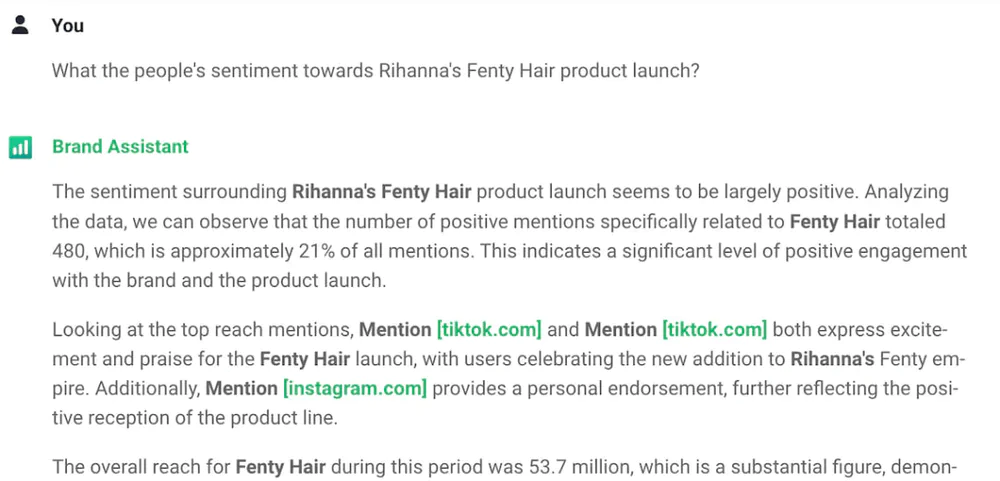
Key features:
- Real-time sentiment analysis
- AI Analysis and Brand Assistant
- Social and non-social mentions volume and reach
- Sentiment reports
- Influencer Score
- Storm Alerts
- Context analysis
Pro’s:
- Many advanced AI features that are quite extra for sentiment analytics software.
- Robust source coverage.
- Real-time insights and alerts to take care of your reputation.
Con’s:
- The tool doesn’t access much historical data.
In short:
Real-time media monitoring across social and non-social platforms with advanced AI features – a great choice for big and enterprise companies.
Bonus: Read about how to do AI customer sentiment analysis in 2025 [A step-by-step guide].
Try the best sentiment analysis tool!
02 Qualtrics
Qualtrics is a platform that helps you understand all about people’s experiences with your brand.
It offers many tools grouped under its Experience Management Platform (EMP), including Customer Experience (CX), Employee Experience, and Strategy & Research.
One of the key strengths of Qualtrics is its sentiment analytics software.
The platform uses a sentiment analysis model called Text iQ. It analyzes written feedback from survey answers and comments on various social media platforms to check if it’s positive, negative, or neutral.
What’s great about Text iQ is that it offers really advanced context analysis.
Additionaly, Qualtrics groups feedback into interrelated topics. That helps in spotting common patterns and trends.
Any downsides?
Well, from the perspective of a small or medium company, Qualtrics is probably too complex and expensive.
Key features:
- Survey creation and management
- Text iQ-powered sentiment analysis
- Thematic analysis
Pro’s:
- Rich dashboard and survey management features.
- Excellent for enterprise-scale feedback analytics.
Con’s:
- Steep learning curve for non-technical users.
In short:
It offers a comprehensive experience management platform with powerful Text iQ for feedback and survey analysis.
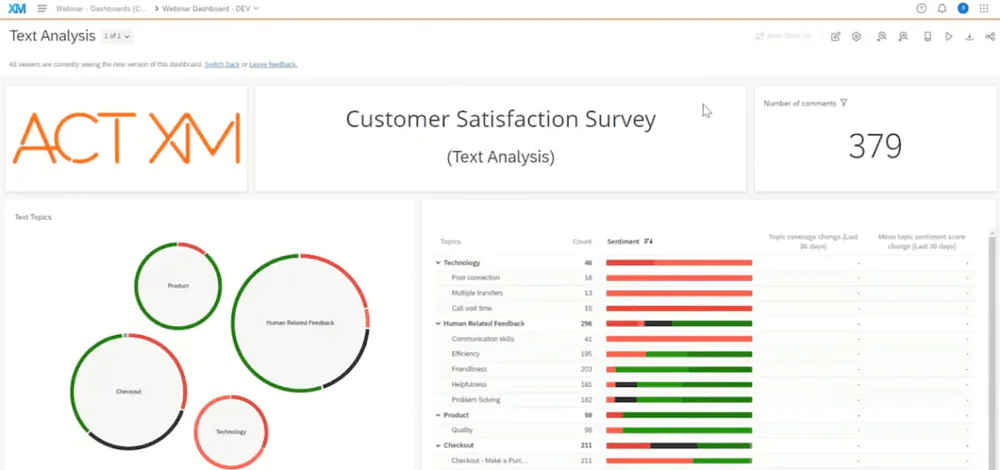
03 OpenText
OpenText is an enterprise information management (EIM) software providing multiple solutions for managing, securing, and analyzing value hidden behind enterprise information.
OpenText’s most crucial feature regarding sentiment analysis is called Magellan Text Mining.
It’s an AI-supported tool that crawls through the content to discover emotions, behaviors, & trends, and presents ready-to-implement insights.
OpenText can detect sentiment in various sources, including unstructured data from documents, social media networks, and customer feedback.
A potential downside of OpenText is that its comprehensive feature set can be too complex and may require significant training to use effectively.
Therefore, it’s recommended mostly for enterprise-sized businesses.
Do you know what people think about your brand?
Key features:
- Advanced sentiment analysis with Magellan Text Mining
- Cross-document analysis for deep-down content understanding
- Multilingual sentiment analysis processing in nearly 40 languages
Pro’s:
- Multilingual and cross-document support.
Con’s:
- Complex to implement and manage.
- Requires training and IT resources.
In short:
Known for enterprise-level EIM and advanced Magellan Text Mining across documents and social sources.
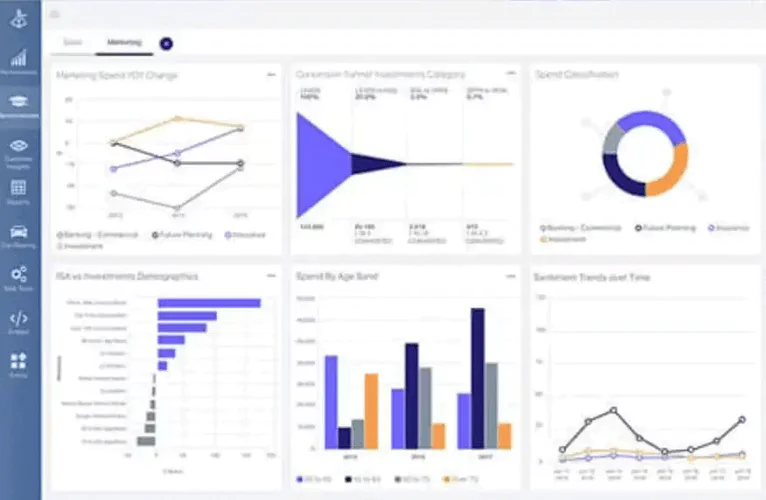
04 Semantria
Semantria is a text analytics and sentiment analysis API that extracts valuable data using natural language processing and machine learning algorithms.
It provides tools to analyze customer feedback and social media content, as well as identify sentiments, themes, and trends.
Semantria’s sentiment analysis capabilities allow users to quickly discover the emotional tone of large volumes of text, making it easier to understand public opinion and customer satisfaction.
However, a potential downside of Semantria is that it can be complex to set up and integrate if you lack technical expertise. Besides, its Excel-styled interface is far from user-friendly.
Key features:
- Customizable Categorization and Named Entity Extraction tools
- Entity recognition
- Multilingual sentiment analysis with over 30 languages supported
Pro’s:
- API access for customizable analytics.
- Multilingual support (30+ languages).
- Entity extraction and topic modeling included.
Con’s:
- Requires technical setup and configuration.
- Excel-like interface is not very intuitive.
In short:
Strong text analytics API, suitable for multi-source and multilingual analysis, geared toward large-scale integration.
Try the best sentiment analysis tool!

05 Medallia
Medallia is a comprehensive customer and employee experience platform (CX/EX platform).
This means it goes beyond just analyzing online conversations to provide a holistic view of how people interact with your brand.
In terms of sentiment analytics software, Medallia gathers feedback from various touchpoints throughout the customer journey.
This includes surveys, website behavior tracking, support interactions, and even product reviews.
Regarding employee experience, Medallia helps capture the sentiment through surveys and pulse checks.
That allows employers to understand employee satisfaction, identify potential issues, and improve company culture.
Both spheres are supported with Medallia’s automated sentiment analysis that can detect specific emotions like frustration, delight, or confusion.
Analyze how people feel about your products!
Key features
- Detailed Sentiment Analysis
- Customer Effort Score (CES)
- Employee Pulse Surveys
- AI-powered Insights
Pro’s:
- Detects nuanced emotions like frustration and delight.
- Strong integration with customer journey touchpoints.
Con’s:
- Complex platform with many overlapping features.
In short:
End-to-end CX/EX platform with sentiment and emotion detection across multiple touchpoints.
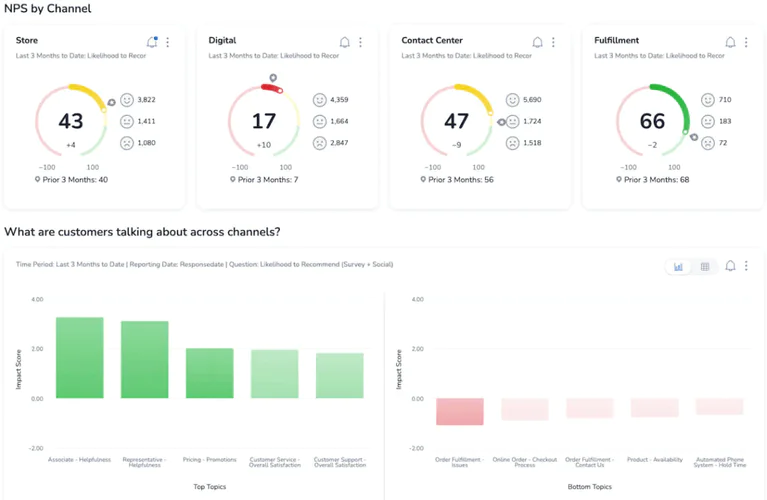
06 MonkeyLearn
In short, MonkeyLearn is a text analysis tool offering handy sentiment analytics software.
It uses machine learning to analyze text data from customer feedback, social media posts, survey responses, and other sources.
What’s great about MonkeyLearn is that, unlike most sentiment analysis tools, it has a no-code setup, which makes the tool a very handy solution for small and medium-sized brands.
The platform allows users to analyze sentiment by categorizing it as positive, neutral, or negative.
Additionally, MonkeyLearn provides customizable sentiment analysis models and real-time data processing for detailed emotion analysis.
Key features
- Open-source API
- Third-party integrations
- Reporting & statistics
Pro’s:
- No-code interface, ideal for small/medium teams.
Con’s:
- May lack enterprise-level data handling.
- Less robust for real-time, high-volume monitoring.
In short:
It’s a flexible no-code platform for building customized sentiment models across datasets.
Try the best sentiment analysis tool!

Top Sentiment Analysis Tools: Social Media Sentiment Analysis Tools
07 Sprout Social
Sprout Social is an all-in-one social media management platform designed to help brands manage their social media presence with just one tool.
Namely, Sprout Social allows you to plan, organize, and schedule social media posts on Facebook, Instagram, LinkedIn, TikTok, Pinterest, and YouTube.
Besides, Sprout Social offers social listening features, including sentiment analysis.
The tool’s sentiment analysis is quite typical. It uses natural language processing to make a detailed emotion analysis and assess if the mention has positive, neutral, or negative sentiment.
But Sprout Social offers something extra – a feature called Sentiment Reclassification that allows you to manually change the sentiment classification if the tool detected it wrongly.
If that’s not enough, you can predefine a set of rules to increase the accuracy of analyzing sentiment.
Key features:
- Sentiment research
- Trend identification
- Sentiment Reclassification
Pro’s:
- Integration with multiple social platforms in one tool.
Cons:
- Sentiment analysis features are only available on Enterprise plans.
In short:
This is a social media management tool that can also perform sentiment analysis.
Know what people say about you on socials!

08 Meltwater
At its core, Meltwater is a media intelligence and social listening tool designed to help businesses track and analyze online news, social media, and other digital content.
It offers a significant number of social media monitoring and competitive analysis features that, combined, provide useful insights into the brand reputation, existing trends, and the overall competitive landscape.
Of course, Meltwater is also a sentiment analytics software!
It allows you to discover emotions from many social media platforms, including X (Twitter), Facebook, Instagram, YouTube, Pinterest, Twitch, and Reddit.
The platform uses artificial intelligence to determine whether brand mentions have neutral, negative, or positive sentiment.
It also provides real-time alerts, allowing you to respond quickly and protect your brand reputation.
Unfortunately, Meltwater is expensive and can exceed the budgets of small or medium companies.
Key features:
- Customizable alerts
- Influencer identification
- Social reporting
Pro’s:
- Real-time alerts for crisis management.
Cons:
- The interface may feel bloated for non-analysts.
In short:
It allows social listening and competitive monitoring across major social networks.

09 Mentionlytics
It’s time to introduce you to the number twelve on our sentiment analysis tools list – Mentionlytics.
In short, Mentionlytics is a web and social media monitoring tool that allows you to track and analyze your brand mentions across multiple social media sites: Facebook, Instagram, YouTube, LinkedIn, Reddit, and X (Twitter).
As for the tool’s sentiment analysis feature, it’s quite usual. Mentionlytics uses natural language processing to discover positive, neutral, or negative sentiment breakdown behind brand mentions.
Of course, the tool is able to present the brand sentiment analysis visually. Green is positive, red is negative, and grey is neutral.
Any downsides? Well, if you’re a fan of nice dashboards and UX you’ll be a bit frustrated with Mentionlytics.
Try the best sentiment analysis tool!
Key features:
- Over 100 supported languages
- Review monitoring
- Email alerts
Pro’s:
- Covers all major social media platforms and includes email alerts.
Cons:
- It is less customizable than some competitors and online sentiment analysis tools.
In short:
This tool provides social media and web monitoring with sentiment visuals and email alerts.

10 Hootsuite
Sentiment analysis is just one of the features in the bigger arsenal of the social media management legend.
As their slogan goes, it provides richer social listening and helps you make smarter business decisions.
The sentiment analysis tool provided by Hootsuite helps you understand your brand sentiment.
The platform will help you mine customer opinions and share insights with your team. Social media data can improve your business’s bottom line.
Once you determine your brand sentiment, you can filter your mentions by language, location, and gender. This helps you build your market segment more structured and detailed.
Real-time access to data from more than 100 million sources in over 50 languages helps you monitor conversations across social, blogs, forums, tc.
Key features:
- Social media data tracking
- Trend discovery
- Advanced and detailed analysis
Pro’s:
- Integrates well into social media management workflows.
Cons:
- Sentiment analysis is a secondary feature, so it lacks more advanced things like emotion detection from textual data.
In short:
It’s a management suite with real-time monitoring from various sources.
Do the sentiment analysis like a pro!

Top Sentiment Analysis Tools: Customer Sentiment Analysis Tools
11 Dialpad
Dialpad is a slightly different sentiment analytics software than the rest on the list.
In general, Dialpad is a cloud-based communication platform for making business calls, sending texts, and holding video meetings.
But when you look deeper, you’ll realize that Dialpad is also a unique real-time sentiment analysis tool. What’s so special about it?
Well, Dialpad AI Contact Center transcribes voice calls in real time. At the same time, artificial intelligence performs live sentiment analysis to detect neutral, positive, or negative sentiment.
Moreover, Dialpad offers AI-powered pop-up cards with conversation tips that appear when the conversation goes wrong. Impressive!
It can be highly beneficial for improving customer satisfaction.
Key features:
- Dialpad AI Contact Center
- Real-time Assist
- QA Scorecard
Pro’s:
- Real-time voice sentiment analysis.
- AI-generated coaching tips during calls.
Cons:
- Narrow focus – only works for live voice/text.
- Less applicable for passive sentiment tracking.
In short:
This sentiment analysis software offers real-time sentiment analysis during live voice calls with AI-powered conversation assistance.

12 Reputation.com
As its name suggests, Reputation.com is a tool focusing on improving your brand awareness.
To be more specific, Reputation.com offers a wide range of services, including review monitoring, online listings analysis, and social media listening.
Reputation.com’s sentiment analysis model uses machine learning and natural language processing to learn how customers feel about your brand, products, or services.
The tool can discover valuable insights like the emotions hidden behind customer feedback, survey responses & social media posts and categorize them into different sentiment buckets (negative, neutral, positive).
As Reputation.com must process massive amounts of data, it must leverage advanced computing resources. Unfortunately, many users report the tool goes pretty slow.
Key features:
- Real-time monitoring
- Actionable insights
- Sentiment score
Pro’s:
- Tracks reviews, surveys, and social sentiment.
- Real-time alerts about negative brand mentions and sentiment changes.
Cons:
- Performance can lag with large datasets.
In short:
This sentiment analytics software aggregates and analyzes customer sentiment from surveys, reviews, and social media to improve brand perception.
The best sentiment analysis tool is on your fingertips!

13 SentiSum
SentiSum is one of the most interesting AI sentiment analysis tools designed to extract in-depth insights from both positive and negative feedback.
The platform goes beyond a basic sentiment analysis.
It enables you to integrate itself with your existing customer support system and analyzes customer interactions from various channels, like emails, chats, phone calls, surveys, and reviews.
SentiSum automatically assigns relevant tags to each conversation by discovering the reason for contact, the customer issue, and the sentiment analysis.
Key features:
- Multi-channel data collection
- Automated tagging
- Over 100 languages supported
Pro’s:
- Integrates with customer support systems.
- Auto-tags topics and reasons for contact.
Cons:
- Tailored more to support analytics than marketing.
In short:
This sentiment analysis software analyzes multi-channel customer support interactions and automates tagging based on contact reasons.
Try the best sentiment analysis tool!

Top Sentiment Analysis Tools: Free Sentiment Analysis Tools
14 Sentigem
Sentigem is a very straightforward sentiment analysis software working in a browser.
You simply visit the Sentigem websites, paste a block of text that you want to inspect, click Analyze, and wham, bam, you’re done! The sentiment behind the mention is there!
The tool’s creators are proud of the speed with which Sentigem analyzes content, and I can vouch for it. I pasted huge chunks of text into the tool and got the results in real-time!
Moreover, Sentigem offers a sentiment analysis API Key to implement.
Unfortunately, the tool is an English-only service.
Key features:
- Quick sentiment analysis
- API Key
Pro’s:
- Browser-based analysis that is simple to use for brand sentiment detection.
- Fast results, even for large text blocks.
Cons:
- English-only.
- No historical tracking or integration with platforms.
In short:
Basic API/browser tool for evaluating customer text blocks, especially for quick checks and prototyping opinion mining.
Discover what others talk about you now!

15 SentiStrength
SentiStrength is different than many sentiment analysis tools. It’s a downloadable software that is primarily a Windows program (but works with Crossover on a Mac, Linux, and Android).
SentiStrength provides automatic sentiment analysis of up to 16,000 social web texts per second with up to human-level accuracy for English.
It is based on two sentiment scores: -1 (not negative) to -5 (extremely negative) and 1(not positive) to 5 (extremely positive)
SentiStrength uses two scores because psychology research has revealed that people process positive or negative sentiments in parallel.
As the tool maker says, keep in mind the results are not always accurate.
It’s because they are guesses using a set of rules to identify words and language patterns usually associated with the sentiment.
Try the best sentiment analysis tool!
Key features:
- One of very few free sentiment analysis tools
- Downloadable
- Open-source and paid API
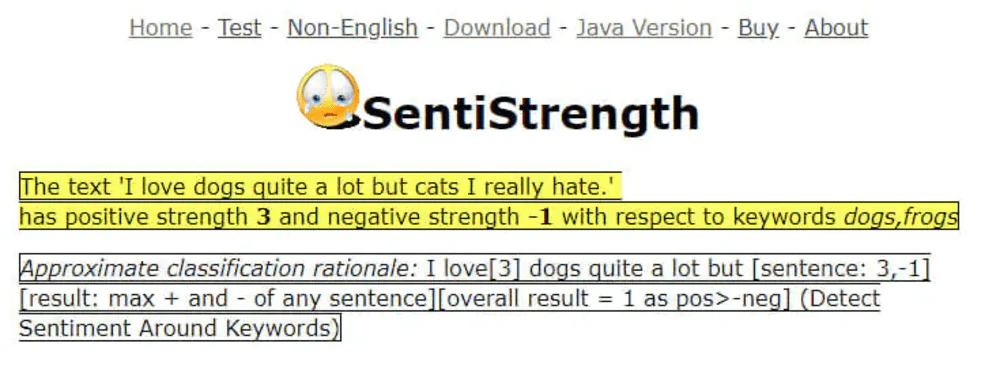
What are the most important features of a great sentiment analysis tool?
To be honest, defining the most important features of a sentiment analytics software resembles choosing a lunch in an Italian restaurant. It depends on your needs and tastes you’re looking for.
But just like pasta and tomatoes are the basis for most dishes in Italian cuisine, there are features that are common for the best sentiment analysis tools:
- Tracking as many sources as possible – social media, review sites, websites, newsletters, etc.;
- Real-time mentions monitoring – to keep you updated and allow you to react quickly to a potential brand reputation crisis;
- AI features – to streamline your sentiment analysis efforts;
- Thematic analysis and trend identification – to have a broader picture of the environment your brand exists in;
- Multilingual support – as many brands expose also to global markets;
- Influencers identification – because some voices online are stronger and impact your sentiment analysis more significantly;
- Customizable reporting – to analyze your sentiment in detail and present the results to stakeholders.

Discover our client’s success story — read the case study.
Wow, your sentiment is amazing! Check by yourself!
Conclusion
Sentiment analysis tools are powerful solutions for understanding how people feel about your brand online.
There are many sentiment-centered platforms on the market. Each offers a unique set of features for analyzing feedback and driving important decisions.
When choosing the right sentiment analysis tool, consider what you expect, what features are most important for your specific needs, and what data sources you want to track.
If you care about your online reputation, you should seriously invest in one.
Thankfully, most tools offer free trials that allow you to test their powers in practice!
Final thoughts:
- Don’t be afraid to experiment with trials – the best sentiment analysis tool depends on your specific needs, from social media focus to real-time crisis monitoring.
- Look for AI-powered features that go beyond basic sentiment to uncover themes and trends in customer feedback, giving you a better understanding of your brand perception.
- Remember, sentiment analysis is just one piece of the puzzle. Use these insights to refine marketing strategies, improve customer service, and ultimately build stronger brand loyalty.
Want to check the best sentiment analysis tool? Try Brand24!
Related articles

![How to do Social Media Sentiment Analysis in 2025? [Easy Guide, Benefits & More!]](https://brand24.com/blog/app/uploads/2023/03/social_media_sentiment_analysis_brand_image_blog_cover_615x345-600x335.webp)

![Digital Reputation: Strategy, Definition and Tips [Guide for 2025]](https://brand24.com/blog/app/uploads/2024/05/digital_reputation@2x-600x335.webp)
![Social Media Reputation: Strategy, Definition and Tips [Guide for 2025]](https://brand24.com/blog/app/uploads/2024/06/social_media_reputation-600x335.webp)
